Name Príncipe de Asturias Ordered 29 May 1977 Construction started 8 October 1979 Length 196 m Beam 31 m | Namesake Príncipe de Asturias Laid down 8 October 1979 Commissioned 30 May 1988 Launched 22 May 1982 Draft 9.4 m | |
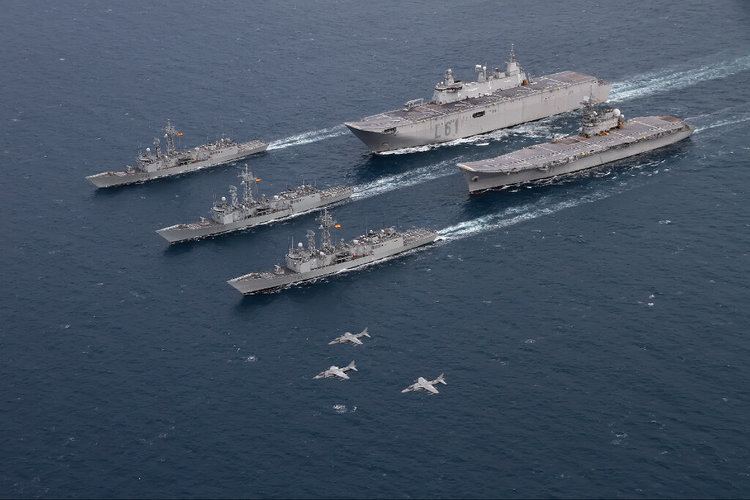 | ||
Príncipe de Asturias, originally named Almirante Carrero Blanco, is an aircraft carrier and was the flagship of the Spanish Navy. She was built in Bazan's Shipyards and delivered to the Spanish Navy on 30 May 1988.
Contents
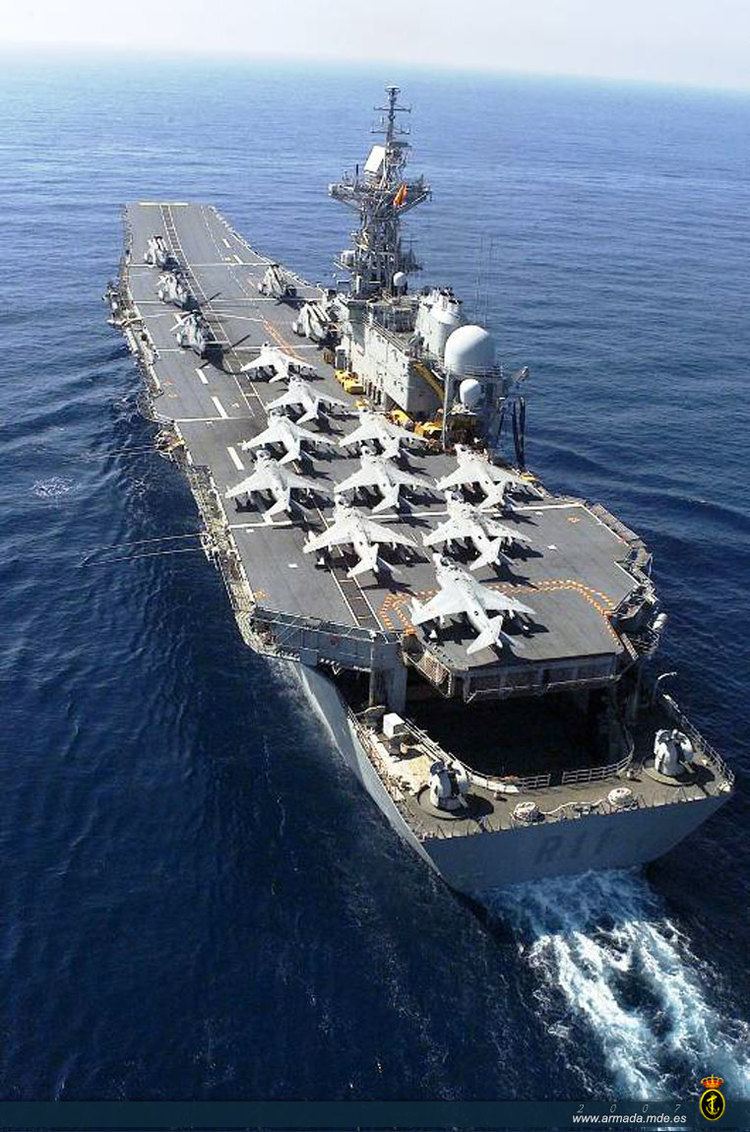
Spain has operated aircraft carriers since the 1920s, initially with the seaplane tender SPS Dédalo and later the multi-role light carrier SPS Dédalo, which was formerly the US Navy's World War II light carrier USS Cabot. Dédalo was replaced as the navy's fleet flagship by Príncipe de Asturias.
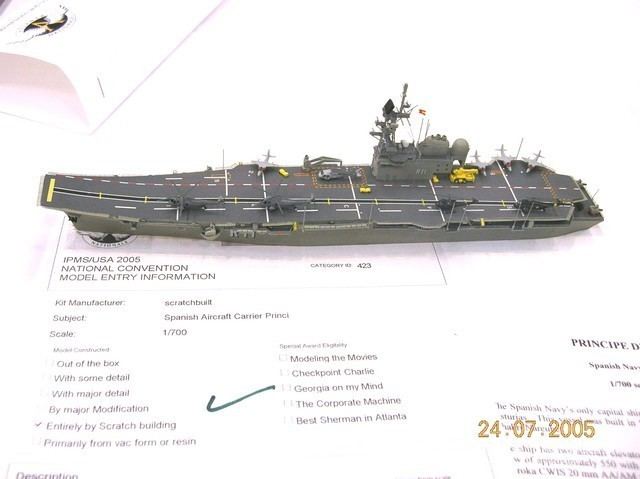
The ship was permanently assigned to the Alpha Group, comprising the carrier and six Santa Maria-class frigates (a Spanish version of the USN Oliver Hazard Perry class). Other vessels such as logistic ships, tankers and corvettes are frequently assigned to the Group when required. Príncipe de Asturias and the Alpha Group have participated in peace support operations in the Adriatic Sea.
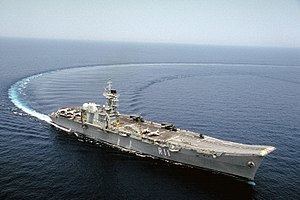
The ship became a victim of defence cuts, being officially decommissioned on 6 February 2013.
Several countries have reportedly expressed interest in buying Príncipe de Asturias before it is dismantled. Indonesia reportedly showed interest, but then decided not to buy. Unconfirmed sources also indicate the Philippines, several Arab countries, and Angola are trying to purchase the Principe de Asturias.
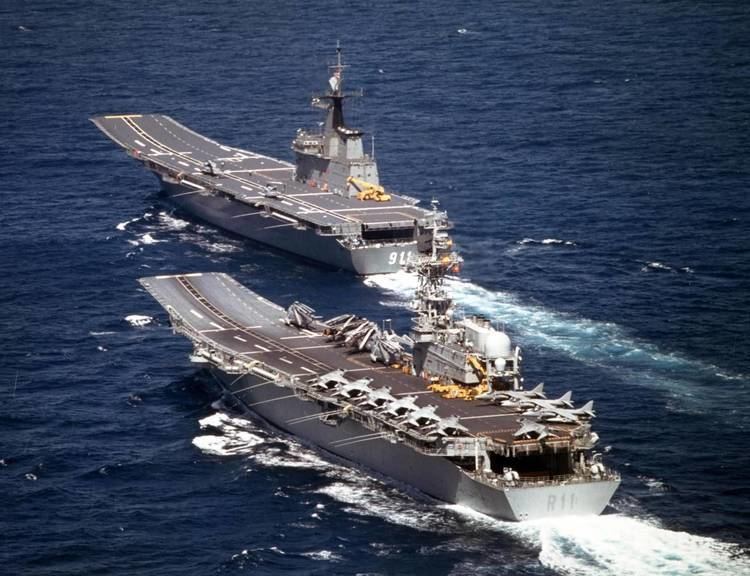
Design

The design is basically that of the initial US Navy's Sea Control Ship design of the 1970s, modified with a ski-jump ramp added to better enable V/STOL aircraft takeoff and other modifications to fit Spanish specifications. Constructed by the National Company Bazan (then Empresa Nacional Bazán, now Navantia) in their shipyard at Ferrol, Príncipe de Asturias was delivered to the Navy on 30 May 1988. The construction process had begun eleven years previously, on 29 May 1977. The processing of the steel began on 1 March 1978 and the keel was laid on 8 October 1979. On 22 May 1982, in a ceremony presided over by Juan Carlos I of Spain, the launch took place, with Queen Sofía of Spain as the ship's sponsor. The ship made her first sea trials in November 1987.
The Thai warship HTMS Chakri Naruebet, delivered in 1997, is based on the Spanish ship's design.
Armament
The self-defense armament includes four close defense Meroka systems and six chaff decoy launchers. For offensive weapons, the ship relies on the capabilities of her embarked aircraft. For anti-submarine defense, she relies upon the detection capacity and attacks of her ASW helicopters and accompanying frigate battle group.
Aircraft
The ship supports 12 AV-8B Harrier II Bravo or AV-8B Harrier II Plus aircraft. The Harriers are armed with AIM-9 Sidewinder and AIM-120 AMRAAM air-to-air missiles, AGM-88 HARM anti-radiation missile and AGM-65 Maverick air-to-ground missiles, in addition to GAU-12U cannon. The carrier also has facilities to support helicopters, usually 6 Sikorsky Sea King SH-3H, 4 Agusta AB-212 and 2 Sikorsky SH-3 AEW (Airborne Early Warning) helicopters.
The ship supports a maximum of 29 fixed wing and rotary wing aircraft with up to 12 on deck and 17 aircraft in the hangar. The hangar which measures 2,398 m² is accessed by two flight deck lifts. The 5,100 square metres (55,000 sq ft) flight deck is 176 metres (577 ft) in length. Operating V/STOL aircraft, the carrier has the characteristic "ski-jump" (12° here), with the runway sightly off the longitudinal axis, tilted portside.
Withdrawal
In May 2012 rumours emerged that Príncipe de Asturias could be withdrawn from active service and placed in a state of "restrictive standby" along with two of the Santa Maria-class frigates, due to the financial pressures on the Spanish government. Annual operating costs for the carrier and its air group reached €100 million. Any decision on the fate of the vessel would have to be taken at the highest possible level due to the status of the ship as the flagship of Spanish Navy.
In November 2012, its decommissioning was confirmed. The official decommissioning ceremony was held on 6 February 2013. Aviation capability is being provided by the landing helicopter dock ship SPS Juan Carlos I. In 2015 it was reported the ship will be sold for scrap the date for which has not been set yet.
